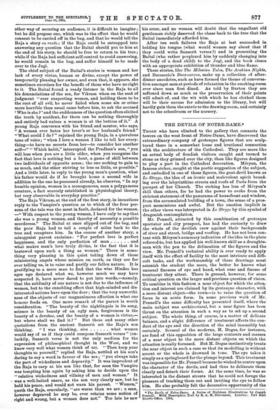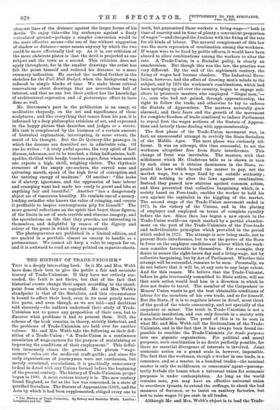THE DEVILS OF NOTRE-D.A.ME.* THOSE who have climbed to the
gallery that connects the towers on the west front of Notre-Dame, have discovered the extraordinary company of grotesque figures that are sculp- tured there in a somewhat loose and irrational connection with the architecture of the Cathedral. They are more like an actual body of fiendish visitors caught and turned to stone as they grinned over the city, than like figures designed to play a part in the Cathedral decoration. Meryon, the famous etcher, caught at the poetic suggestion of the subject, and embodied in one of those figures, the goat-devil known as Le Stryge, the idea of an ironic and malevolent spirit brood- ing over the labyrinthine streets and roofs of Paris from the parapet of her Church. The etching has less of Meryon's skill than others, for he had the power to evoke from the strictest statement of the panorama of housefront and window, from the accumulated building of a town, the sense of a pros- pect momentous and awful. But the emotion implicit in the other views was interpreted in Le Stryge by this symbol of dragonish contemplation.
Mr. Pennell, attracted by this combination of grotesque spectator and city prospect, has had the curiosity to draw the whole of the devilish crew against their backgrounds of river and street, bridge and rooftop. He has not been con- tent with Meryon's summary indication of the idea in the plate referred to, but has applied his well-known skill as a draughts- man with the pen to the delineation of the figures and the view. Mr. Pennell's technical ability is ever ready to apply itself with the effect of facility to the most intricate and diffi- cult tasks, and the workmanship of these drawings must astonish the student the more, the better he knows what unusual fineness of eye and hand, what ruse and finesse of treatment they attest. There is ground, however, for some critical question on the larger and previous question of vision. To combine in this fashion a near object for which the atten- tion and interest are claimed by its grotesque character, with a more distant object—the town—is to raise the question of focus in an acute form. In some previous work of Mr. Pennell's the same difficulty has presented itself, where the main subject was architectural, but a near figure has been thrust on the attention in such a way as to set up a second subject. The whole thing, of course, is a matter of delicate balance, and a slight difference of treatment affects the con- duct of the eye and the direction of the mind insensibly but certainly. Several of the moderns, M. Degas, for instance, are fond of this opposition of the large contours and masses of a near object to the more distant objects on which the attention is really focussed. But M. Degas instinctively treats the near object in such a case so that its modelling is without accent or the whole is drowned in tone. The eye takes it simply as a springboard for the plunge beyond. This treatment was impossible for Mr. Pennell because he wished to centre upon the character of the devils, and had thus to delineate them clearly and detach their forms. At the same time, he was so interested in the distant streets that he could not forego the pleasure of tracking them out and inviting the eye to follow him. He also probably felt the decorative opportunity of the
• The Devils of Notre-Dante. A Series of Eighteen Illustrations by Joseph Pennell. With Descriptive Text by R. A. M. Stevenson. London Pail Mott Gazette Office. 1894. close-set lines of the distance against the larger forms of his devils. To enjoy this—the big arabesque against a finely reticulated ground—perhaps a simpler convention would be the more effective means—the use of line without suggestion of shadow or distance—some means anyway by which the two could be more effectually tied up. As it is, our criticism of the more elaborate plates is that the devil is projected as one subject and the town as a second. This criticism does not apply throughout, for in the smaller drawings the artist has felt the point himself and reduced his distance to a more summary indication. He carried the method further in the sketches for the Pall Mall Budget, when the background was reduced to simple blocks of tone. We make these critical reservations about drawings that are nevertheless full of interest, and that no one but their author has the knowledge of architectural expression and of picturesque effect to have done so well.
Mr. Stevenson's part in the publication is an essay, or meditative rhapsody, on the art and significance of those sculptures; and like everything that comes from his pen, it is informed by a deep philosophic criticism of art, and expressed in the happy phrase that describes and judges at a stroke. His task is complicated by the business of a certain amount of historical explanation, interrupting, to some extent, the mood of his thought. But the De Quincey-like passages in which the demons are described are in admirable vein. Of one he writes : "A truly awful spectre, the very spirit of foul disease, inhuman, not to be touched, a thing half-asinine, half- apelike, thrilled with heady, baseless anger, from whose month one expects a high, shrill, neighing clatter. The rhythmic structure of the empty eye-sockets, the curved nose and quivering mouth, speak of the high fever of corruption and the untiring energy of madness." Of another : " She looks as if slavery, ignorance, and the oppression of base labour and cramping want had made her ready to growl and bite at anything fair and beautiful." Another "has a dangerously abject air of rancorous humility. He reminds one of a money- lending swindler who knows the value of cringing, and counts it profitable to inspire contemptuous pity for himself." The more general reflections on the spirit that begot these figures, of the limits in art of such terrible and obscene imagery, and the speculations on life that they provoke, are interesting in themselves, and delightful by reason of the dignity and colour of the prose in which they are expressed.
The photogravures are published in a limited edition, and are packed in a portfolio almost as uneasy to handle as a portmanteau. We cannot all keep a valet to unpack for us, and it is awkward to read an essay printed on separate sheets.



















































 Previous page
Previous page